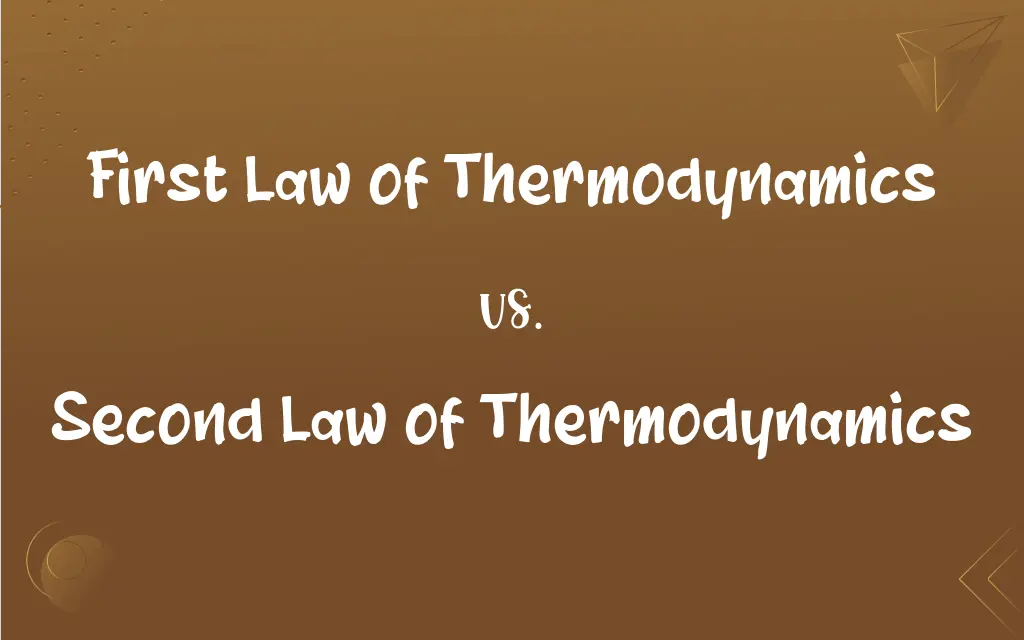First Law of Thermodynamics vs. Second Law of Thermodynamics: What's the Difference?
Edited by Aimie Carlson || By Harlon Moss || Updated on October 16, 2023
The first law of thermodynamics states energy cannot be created or destroyed, only transferred or converted, while the second law asserts that energy transformations increase the universe's entropy.

Key Differences
The first law of thermodynamics, often referred to as the law of energy conservation, asserts that energy cannot be created or destroyed in an isolated system. This law emphasizes the conservation aspect of energy, ensuring that the total energy remains constant even if transformations occur. Conversely, the second law of thermodynamics concerns the quality of energy and posits that energy always flows from areas of higher concentration to areas of lower concentration, leading to an increase in entropy or disorder.
The first law of thermodynamics assures that while energy might change forms, such as from kinetic to potential, the total amount of energy in a closed system remains unchanged. On the other hand, the second law of thermodynamics indicates that not all energy in a system is useful or available for work, as some energy is inevitably lost, often in the form of heat.
Regarding practical implications, the first law of thermodynamics implies that perpetual motion machines of the first kind, which create energy without input, are impossible. In contrast, the second law of thermodynamics suggests that perpetual motion machines of the second kind, which convert heat entirely into work without any energy loss, are also impossible.
Underlying the first law of thermodynamics is the principle that energy, whether it be in the form of heat, work, or internal energy, will always be conserved. The second law of thermodynamics, however, is rooted in the observation that certain energy transformations are irreversible, and natural processes will move towards a state of maximum disorder or entropy.
Comparison Chart
Core Principle
Energy conservation.
Increase in entropy.
ADVERTISEMENT
Energy's State
Energy can't be created/destroyed, only transformed.
Energy dissipates; not all is usable for work.
Perpetual Motion Machine
Makes first kind (creating energy without input) impossible.
Makes second kind (total heat-to-work conversion) impossible.
Practical Implication
Total energy remains constant in closed systems.
Energy systems naturally evolve to higher entropy states.
Relevance to Natural Processes
Dictates energy's constancy despite transformations.
Explains the directionality and irreversibility of processes.
First Law of Thermodynamics and Second Law of Thermodynamics Definitions
First Law of Thermodynamics
The first law of thermodynamics states energy's conservation in a system.
According to the first law of thermodynamics, energy can change forms but not vanish.
ADVERTISEMENT
Second Law of Thermodynamics
The second law of thermodynamics portrays the directionality of natural events.
The second law of thermodynamics clarifies why spontaneous reactions have a preferred direction.
First Law of Thermodynamics
The first law of thermodynamics underscores the preservation of energy's total quantity.
The first law of thermodynamics confirms the energy balance in closed systems.
Second Law of Thermodynamics
The second law of thermodynamics denotes the increase in entropy.
The second law of thermodynamics explains why ice melts at room temperature.
First Law of Thermodynamics
The first law of thermodynamics reflects energy's transferability and convertibility.
The first law of thermodynamics allows energy's transformation from heat to work.
Second Law of Thermodynamics
The second law of thermodynamics indicates the natural flow of energy.
Due to the second law of thermodynamics, heat flows from hot to cold objects.
First Law of Thermodynamics
The first law of thermodynamics emphasizes energy's constancy.
The first law of thermodynamics highlights that total energy remains unchanged, even if it shifts from potential to kinetic.
Second Law of Thermodynamics
The second law of thermodynamics asserts energy's dissipative nature.
The second law of thermodynamics shows that not all heat can be wholly converted into work.
First Law of Thermodynamics
The first law of thermodynamics prohibits energy's creation or annihilation.
Perpetual motion machines defy the first law of thermodynamics since they imply energy creation from nothing.
Second Law of Thermodynamics
The second law of thermodynamics elucidates irreversible processes.
The second law of thermodynamics is why mixing milk and coffee can't be undone.
FAQs
How does the first law relate to internal energy?
It describes the change in a system's internal energy as equal to the energy added as heat minus the energy lost as work.
Is energy loss due to the first law?
No, while energy may change forms or be transferred, its total amount remains constant in an isolated system.
Is the first law also known by another name?
Yes, it's often referred to as the "law of conservation of energy."
How is the first law represented mathematically?
ΔU = Q - W, where ΔU is the change in internal energy, Q is the heat added, and W is the work done by the system.
What is the first law of thermodynamics?
It states that energy cannot be created or destroyed, only transferred or converted from one form to another.
Can the first law predict the direction of energy flow?
No, it only states energy conservation, not the direction of energy processes.
Does the first law apply to all energy changes?
Yes, it applies universally to all processes involving energy.
What is entropy?
Entropy measures the amount of disorder or randomness in a system.
What's the concept of a heat engine in relation to the second law?
A heat engine operates between two temperature reservoirs and its efficiency is limited by the second law.
What's a practical implication of the second law?
Refrigerators, air conditioners, and car engines all operate with considerations of the second law's implications.
Who contributed to the development of the second law?
Key contributors include Rudolf Clausius, Lord Kelvin, and Sadi Carnot.
Who formulated the first law of thermodynamics?
The law was developed over time, with contributions from many scientists including James Joule.
How is the second law expressed in terms of temperature?
Heat flows spontaneously from a hotter body to a colder one, not in the reverse, due to this law.
Is the increase of entropy a measure of energy dispersal?
Yes, as entropy increases, energy becomes more spread out and less available for work.
Is the first law valid for both macroscopic and microscopic systems?
Yes, it is valid at both scales.
How does the second law relate to energy efficiency?
It implies that no energy transfer can be 100% efficient, as some energy will always increase the system's entropy.
What is the second law of thermodynamics?
It states that the total entropy, or disorder, of an isolated system can never decrease over time.
Why is the second law significant?
It dictates the direction of spontaneous processes and sets limits on energy conversion.
Can the second law be violated?
No, it's a fundamental principle of nature, and no known processes violate it.
What's a practical application of the first law?
It's applied in calorimetry to measure heat exchange.
About Author
Written by
Harlon MossHarlon is a seasoned quality moderator and accomplished content writer for Difference Wiki. An alumnus of the prestigious University of California, he earned his degree in Computer Science. Leveraging his academic background, Harlon brings a meticulous and informed perspective to his work, ensuring content accuracy and excellence.
Edited by
Aimie CarlsonAimie Carlson, holding a master's degree in English literature, is a fervent English language enthusiast. She lends her writing talents to Difference Wiki, a prominent website that specializes in comparisons, offering readers insightful analyses that both captivate and inform.































































